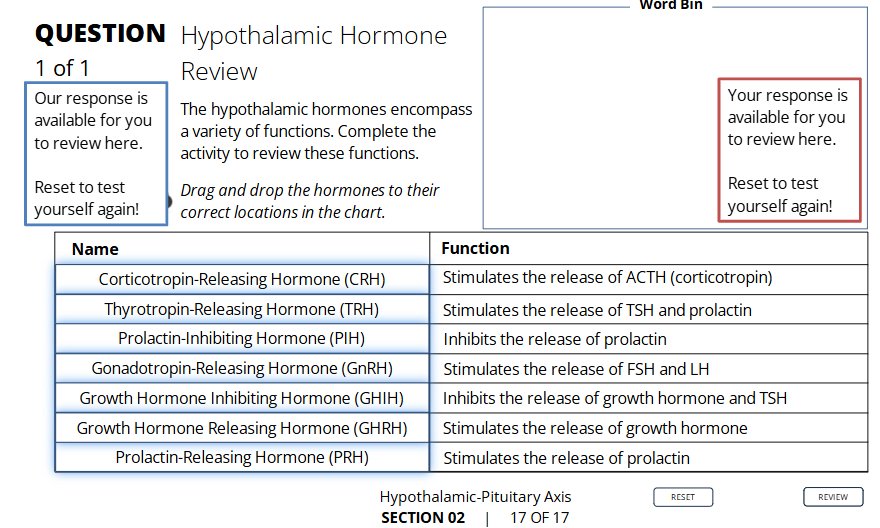SECTION 02: HYPOTHALAMIC-PITUITARY AXIS
1/82
There's no tags or description
Looks like no tags are added yet.
Name | Mastery | Learn | Test | Matching | Spaced |
|---|
No study sessions yet.
83 Terms
By the end of Section 02, you should be able to:
Describe the structure and function of the hypothalamic-pituitary axis.
• Differentiate between the hormones of the anterior and posterior pituitary.
• Describe the importance of the hypothalamic-hypophyseal portal system.
• Understand negative feedback as it applies to hormones of the hypothalamic-pituitary axis.
Why do the nervous + endocrine systems work together?
✔ To keep your body balanced (homeostasis).
✔ They both send signals to control body functions—but in different ways.
Response Time

Duration of Effects

Number of Targets

How do they send signals? (from the diagram)
(a) Endocrine (hormones):
Endocrine cell releases hormone ➔
Hormone travels through blood ➔
Reaches many places in the body.
(b) Nervous system (neurons):
Nerve cell sends electric impulse ➔
Signal travels along nerve fibers ➔
Goes to one specific spot.
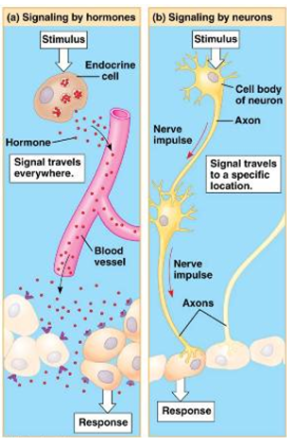
Bonus fact
Some glands (like the pituitary gland) use both neural and endocrine control to work—so the two systems are linked.
What is the pituitary gland?
✔ A tiny gland located at the base of the skull inside a bony cavity.
Why is the pituitary gland important?
✔ It’s often called the “master gland” because it controls many other glands and body functions using hormones.
What are the 2 parts of the pituitary gland?
1⃣ Anterior pituitary (front)
2⃣ Posterior pituitary (back)
Do the 2 lobes communicate?
❌ Nope!
They are completely separate—both anatomically (structure) and functionally (what they do).
What is the posterior pituitary made of?
✔ Neural-like tissue (it acts more like a part of the brain).
✔ Also called the neurohypophysis.
What is the anterior pituitary made of?
Glandular (epithelial) tissue (makes and releases its own hormones).
✔ Also called the adenohypophysis.
Simple diagram labels to remember
Hypothalamus: Boss of the pituitary.
Anterior pituitary: Gland tissue (adenohypophysis).
Posterior pituitary: Neural tissue (neurohypophysis).
Connecting stalk: Links the hypothalamus to the pituitary.
Optic chiasm: Where optic nerves cross—just nearby anatomically.
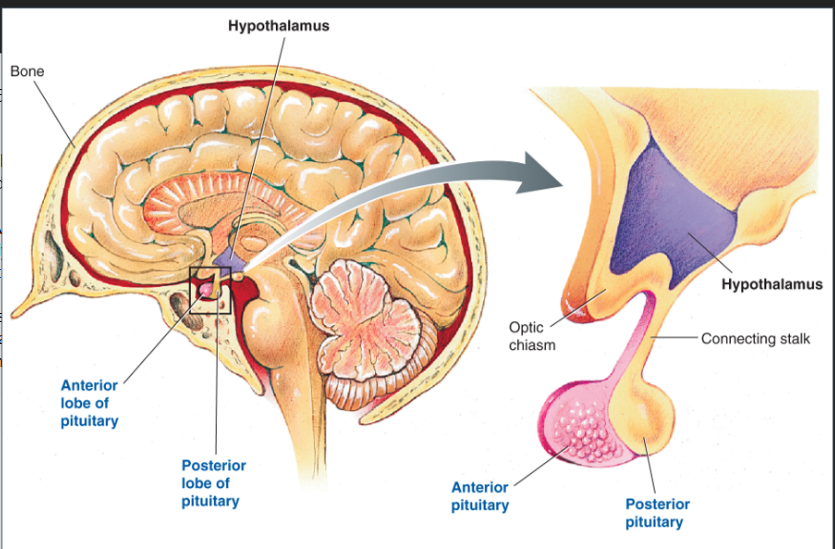
What does the hypothalamus do?
✔ The hypothalamus is like the boss of the pituitary gland.
✔ It tells both the anterior and posterior lobes when to release hormones.
How does the hypothalamus talk to the posterior pituitary?
✔ It’s connected by a neural pathway (like a nerve connection).
✔ Hormones are made in the hypothalamus but stored + released by the posterior pituitary.
What are the key structures for the posterior pituitary?
Supraoptic nucleus
Paraventricular nucleus
➡ These are clusters of neurons in the hypothalamus.
➡ Their axons (nerve fibers) run down the pituitary stalk into the posterior pituitary.
Posterior pituitary = like a delivery truck
✔ Hormones are made in the hypothalamus
✔ Travel down the nerve fibers
✔ Get released into the blood from the posterior pituitary.
Example: Oxytocin and ADH (antidiuretic hormone).
How does the hypothalamus talk to the anterior pituitary?
✔ Through a special blood system called the hypothalamic-hypophyseal portal system (like a private blood highway).
What happens in the anterior pituitary?
✔ The hypothalamus releases "releasing hormones" into the portal system.
✔ These hormones travel through the blood to the anterior pituitary.
✔ They tell the anterior pituitary to make and release its own hormones.
Anterior pituitary = hormone factory
✔ The anterior pituitary makes its own hormones.
✔ But it needs instructions from the hypothalamus first (the releasing factors).
Key terms to know
Pituitary stalk: The connection between the hypothalamus and pituitary.
Hypothalamic-hypophyseal portal system: The special blood vessels that carry releasing hormones from the hypothalamus to the anterior pituitary.
Easy summary
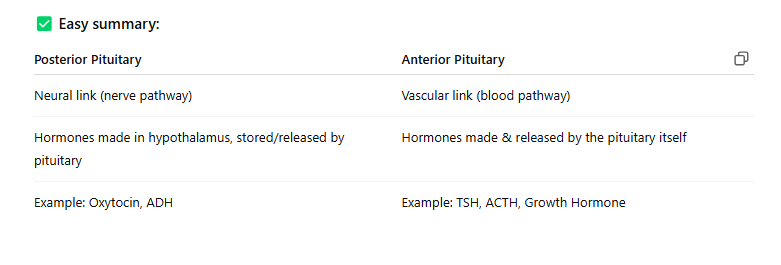
Where are posterior pituitary hormones made?
✔ In the hypothalamus!
NOT made in the posterior pituitary itself.
The hormones are packaged into vesicles and sent down to the posterior pituitary to be stored + released.
How are hormones released?
✔ When the hypothalamus gets a signal/stimulus,
✔ it sends an action potential (nerve signal) down to the posterior pituitary.
✔ This triggers the hormones to be released into the blood.
What are the 2 main posterior pituitary hormones?
1⃣ Vasopressin (aka ADH)
2⃣ Oxytocin
What does vasopressin (ADH) do?
Main job 1: 🏃♂💧
✔ Works on the kidneys.
✔ Makes the kidneys keep water (increases water reabsorption).
✔ ➔ Helps the body stay hydrated.
Main job 2: 💥🩸
✔ Works on blood vessels (arterioles).
✔ Causes vasoconstriction (narrows the vessels).
✔ ➔ Helps raise blood pressure.
✅ Most important effect: Water retention by kidneys.
What does oxytocin do?
Main job 1: 🤰
✔ Works on the uterus.
✔ Makes the uterus contract during childbirth.
Main job 2: 🤱
✔ Works on the mammary glands.
✔ Helps release milk during breastfeeding.
What does the anterior pituitary do?
✔ It makes & releases 6 hormones.
✔ All are peptide hormones (made of amino acids).
What’s a tropic hormone?
✔ A tropic hormone is a hormone that stimulates another endocrine gland to make & release its hormones.
Example: TSH is a tropic hormone because it tells the thyroid gland what to do.
What is TSH?
✔ TSH = Thyroid-Stimulating Hormone (also called thyrotropin).
It’s made by the anterior pituitary.
Its job: Tell the thyroid gland to release thyroid hormones.
What happens when TSH is released?
1⃣ TSH stimulates the thyroid gland.
2⃣ The thyroid gland releases:
T3 (triiodothyronine)
T4 (thyroxine)
3⃣ These thyroid hormones increase your metabolic rate.
Why is TSH important?
✔ It keeps your metabolism running properly.
✔ If TSH or thyroid hormones are out of balance, you can have:
Hypothyroidism (slow metabolism)
Hyperthyroidism (fast metabolism)
What is LH?
✔ LH = Luteinizing Hormone.
✔ Made by the anterior pituitary.
What does LH target?
✔ Gonads (sex organs):
Ovaries in females
Testes in males
What does LH do in females?
✔ 3 big jobs:
1⃣ Triggers ovulation (the release of an egg).
2⃣ Helps form the corpus luteum (the structure that makes hormones after ovulation).
3⃣ Stimulates the ovaries to release:
Estrogen
Progesterone
What does LH do in males?
✔ Stimulates the testes (Leydig cells) to make:
➡ Testosterone.
What is Prolactin (PRL)?
✔ Prolactin (PRL) is a hormone made by the anterior pituitary.
Is prolactin a tropic hormone?
❌ No!
✔ It’s the only anterior pituitary hormone that is NOT tropic.
✔ That means it acts directly on its target (no other glands involved).
What does prolactin do in females?
✔ Acts on the mammary glands.
✔ Helps with:
1⃣ Breast growth (development)
2⃣ Milk production (secretion)
What does prolactin do in males?
✔ It exists in males, but its purpose is unclear.
What is FSH?
✔ FSH = Follicle-Stimulating Hormone.
✔ Made by the anterior pituitary.
What does FSH target?
✔ Gonads (sex organs):
Ovaries in females
Testes in males
What does FSH do in females?
✔ 2 main jobs:
1⃣ Stimulates growth & development of ovarian follicles (the sacs where eggs develop).
2⃣ Promotes estrogen production by the ovaries.
What does FSH do in males
✔ Required for sperm production in the testes.
What is Growth Hormone (GH)?
✔ GH = Growth Hormone (also called Somatotropin).
✔ Made by the anterior pituitary.
What does GH do?
✔ Main job:
Regulates overall body growth.
Also helps with metabolism.
How does GH help growth?
1⃣ GH acts on the liver.
2⃣ The liver releases IGF-1 (Insulin-like Growth Factor-1).
3⃣ IGF-1 helps:
Bones grow
Soft tissues grow
How does GH affect metabolism?
✔ GH acts directly on:
Adipose tissue (fat)
Muscles
Liver
➡ These actions change how your body uses energy (metabolic actions).
GH can have + or – effects
✔ Depending on the tissue, GH can:
Stimulate ( + ) certain actions
Or inhibit ( – ) others
(This helps balance growth + metabolism.)
What is ACTH?
✔ ACTH = Adrenocorticotropic Hormone (also called adrenocorticotropin).
✔ Made by the anterior pituitary.
What does ACTH target?
✔ The adrenal cortex (outer layer of the adrenal gland).
What does ACTH do?
✔ Stimulates the adrenal cortex to release cortisol.
What is cortisol?
✔ A stress hormone.
✔ Helps control:
Metabolism (how your body uses fats, proteins, and sugars)
The body’s stress response
Step-by-step flow

Activity pt 1
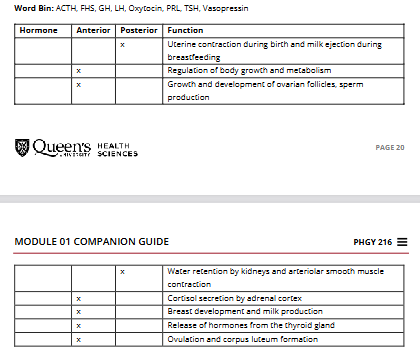
Activity pt 2

What is the hypothalamic-hypophyseal portal system?
✔ A special blood vessel system that connects the:
➡ Hypothalamus ➔ Anterior pituitary.
What does the portal system do?
✔ It carries releasing/inhibiting hormones from the hypothalamus directly to the anterior pituitary.
What are hypophysiotropic hormones?
✔ These are the hormones made by the hypothalamus that:
Tell the anterior pituitary to RELEASE hormones (releasing hormones)
Or tell it to STOP releasing (inhibiting hormones)
Step-by-step flow of the portal system
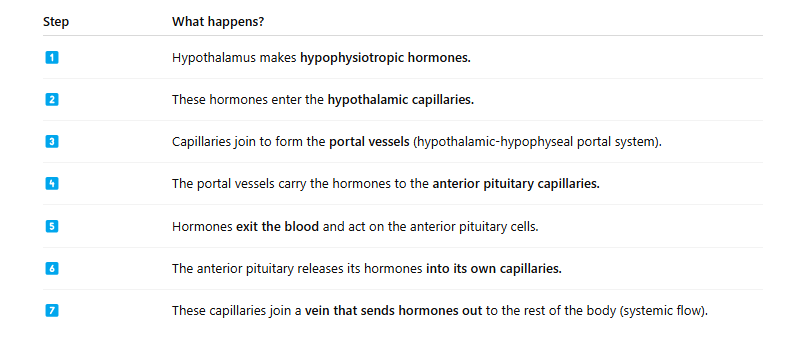
Why is this system important?
✔ It allows the hypothalamus to control the anterior pituitary quickly and directly—no need for hormones to go around the whole body first.
Simple diagram flow (for memory)
1⃣ Hypothalamus ➔
2⃣ Hypothalamic capillaries ➔
3⃣ Portal vessels ➔
4⃣ Anterior pituitary capillaries ➔
5⃣ Hormone release ➔
6⃣ Vein ➔ Body circulation
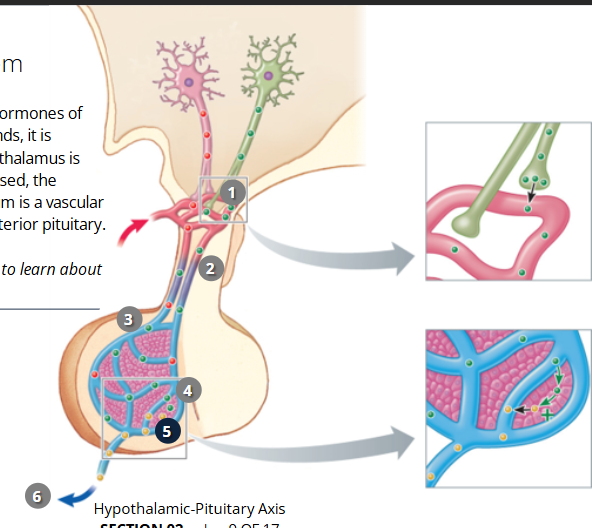
What is this diagram showing?
✔ It shows how the hypothalamus controls the anterior pituitary using releasing & inhibiting hormones.
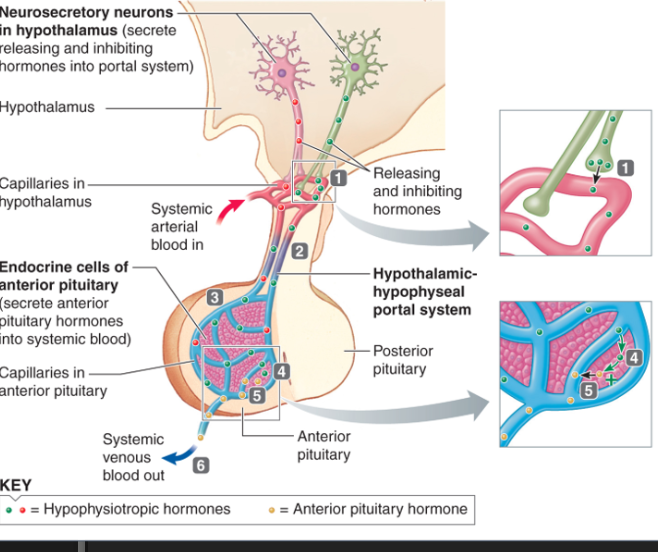
Step-by-step (diagram flow)
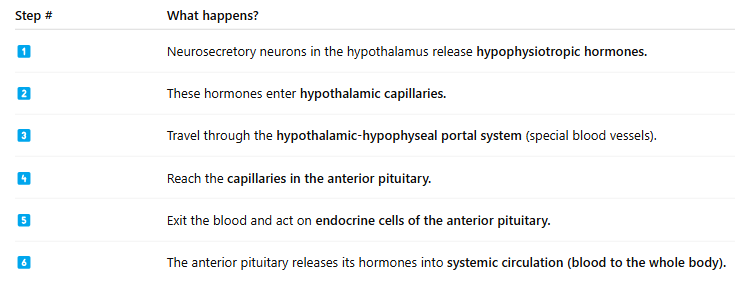
What do the color dots mean?
✔ Green dots: Hypothalamic (releasing/inhibiting) hormones
✔ Yellow dots: Anterior pituitary hormones
Hypothalamic hormones + their jobs
1⃣ GHIH (Growth Hormone Inhibiting Hormone)
🚫 Inhibits growth hormone (GH) and TSH.
2⃣ PIH (Prolactin-Inhibiting Hormone)
🚫 Inhibits prolactin.
3⃣ PRH (Prolactin-Releasing Hormone)
✅ Stimulates prolactin.
4⃣ TRH (Thyrotropin-Releasing Hormone)
✅ Stimulates TSH and prolactin.
5⃣ GHRH (Growth Hormone Releasing Hormone)
✅ Stimulates growth hormone (GH).
6⃣ GnRH (Gonadotropin-Releasing Hormone)
✅ Stimulates FSH and LH.
7⃣ CRH (Corticotropin-Releasing Hormone)
✅ Stimulates ACTH.
Simple match-up chart
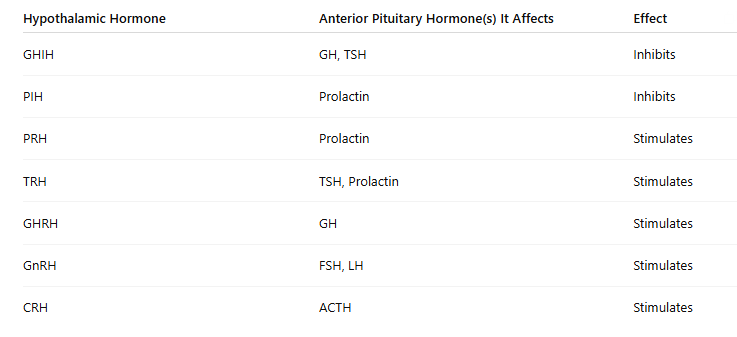
Why is this system important?
✔ It allows the hypothalamus to have tight control over what hormones the anterior pituitary releases—keeping everything balanced.
What controls hypothalamic hormones?
✔ Hypothalamic hormones are controlled by many inputs:
Neural input (nerve signals)
Hormonal input (signals from hormones in the blood)
Both can stimulate (+) or inhibit (–) hormone release.
What is special about the hypothalamus?
✔ Some parts of the hypothalamus don’t have a blood-brain barrier.
➡ This means the hypothalamus can "sample" blood directly and respond to things like:
Chemicals
Changes in plasma (e.g., osmolarity—how salty the blood is)
What other brain areas influence the hypothalamus?
✔ The hypothalamus gets signals from:
Stress-related brain areas
Emotion-related brain areas
Why is stress important?
✔ Stress is a major factor that can increase or decrease the release of hypothalamic hormones.
What is the blood-brain barrier?
✔ A protective shield that separates blood from the brain.
✔ It’s selective—only lets certain things pass through to keep the brain safe.
What is this diagram showing?
✔ It shows the 3-hormone chain of command:
1⃣ Hypothalamus
2⃣ Anterior pituitary
3⃣ Target endocrine gland
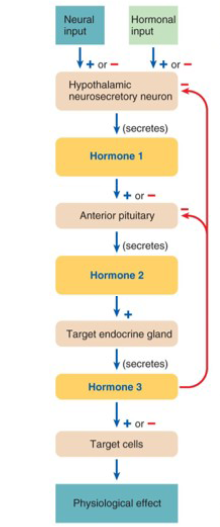
Step 1 (Hypothalamus)
✔ The hypothalamus gets neural & hormonal inputs (signals).
✔ It secretes Hormone 1 (releasing/inhibiting hormones).
➡ This hormone travels to the anterior pituitary.
Step 2 (Anterior Pituitary)
✔ The anterior pituitary responds by releasing Hormone 2 (a tropic hormone).
➡ This hormone goes into the blood and targets an endocrine gland.
Step 3 (Target Endocrine Gland)
✔ The target gland secretes Hormone 3 (the final hormone).
✔ Hormone 3 goes to the target cells to create a physiological effect.
What is negative feedback?
✔ Hormone 3 loops back and tells the hypothalamus + pituitary to slow down production.
✔ This keeps the system balanced (prevents overproduction).
Easy step-by-step summary
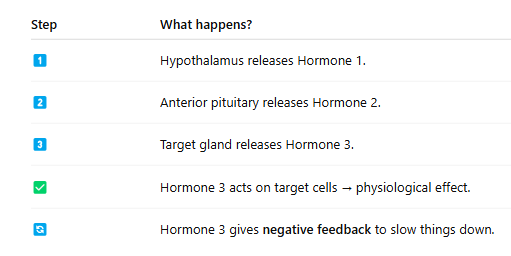
Why is this important?
✔ This chain keeps hormones in balance.
✔ Helps the body respond to changes (like stress, growth needs, etc.) but also prevents overproduction.
Cortisol Stress Response (Chain of Command)
1⃣ Stress ➔ Hypothalamus
The hypothalamus releases:
✔ Corticotropin-Releasing Hormone (CRH)
2⃣ CRH ➔ Anterior Pituitary
The anterior pituitary releases:
✔ Adrenocorticotropic Hormone (ACTH)
3⃣ ACTH ➔ Adrenal Cortex
The adrenal cortex releases:
✔ Cortisol (the main stress hormone)
4⃣ Cortisol ➔ Body Cells
Cortisol causes:
✔ Metabolic changes that help the body resist stress.
5⃣ Negative Feedback Loop:
Cortisol sends signals back to the:
✔ Hypothalamus & Anterior PituitaryThis tells them to reduce CRH & ACTH production to keep things balanced.
Easy way to remember:
Stress → CRH → ACTH → Cortisol → Stress relief + negative feedback.
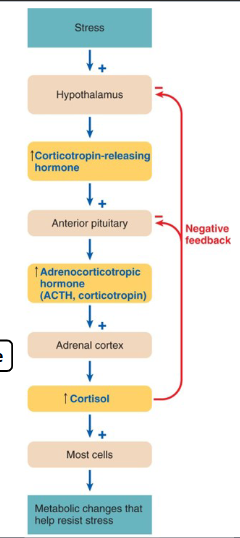
Another question
